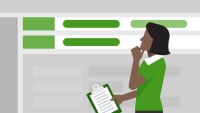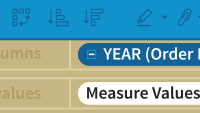Description
You'll begin by creating data visualisations and dashboards that are as effective as possible for your target audiences. Then you'll draught presentations that use storytelling techniques, visualisations, and animations to provide data-driven recommendations.
Syllabus:
Course 1: Intro to Data Visualization
Data Visualization Fundamentals
- Evaluate the quality of data visualizations and build high- quality visualizations.
Design Principles
- Implement the best design practices, and use the most appropriate chart for a particular situation
Creating Visualizations in Tableau
- Build data visualizations in Tableau
- Use data hierarchies, filters, groups, sets, and calculated fields.
- Create map-based data visualizations in Tableau.
Telling Stories with Tableau
- Build interactive Tableau dashboards.
- Construct a data story using Tableau Storypoint
Project: Build Data Dashboards
- Working with data necessitates the exchange of insights. In this project, you will use Tableau to create interactive dashboards. You'll use a dataset of flight delays in the United States to visualise the quality of airlines and airports, as well as find the best times to fly. These types of visualisations aid in decision making in order to achieve the best results.
Course 2: Dashboard Design
Planning Phase
- Uncover and understand user needs for a dashboard project.
- Determine the level of the audience’s graphicacy.
- Identify measurable key metrics.
Design Phase
- Design a dashboard using sketching and wireframing.
- Build a simple dashboard prototype.
Prototyping & Feedback
- Gather feedback from dashboard users.
- Iterate on the prototype and complete a finished dashboard
Project: Design a Dashboard, Part 1
- In this project, you will sketch and wireframe a dashboard prototype for a specific audience. The goal of this project is to go through the dashboard prototyping and wireframing stages. This will entail investigating and comprehending the data, as well as creating prototypes. You will design a proof-of-concept dashboard to explore the data in a variety of ways.
Project: Design a Dashboard, Part 2
- In this project, you will convert the prototype into a final design of the dashboard for the target audience. The design will be defined by the audience's graphic literacy, data literacy, domain expertise, user type, most important business metrics, and any other attributes that may influence the design. The primary goal of this dashboard is to ensure that the appropriate data has been selected for the decisions that must be made. The dashboard will then be truly insightful by adding design elements that draw the user's eye to data-driven points of interest. You'll modify your visualizations to highlight the most important points and add interactivity to further facilitate the users' desired actions.
Course 3: Data Storytelling
Define Problem Statement
- Clearly articulate and communicate a problem statement for a data project
Building a Ghost Deck
- Create an issue tree and hypothesis-driven structure
- Create a “ghost deck” — a skeleton deck commonly used by management consultants to identify a client’s needs.
Limitations and Biases
- Identify potential limitations and sources of bias in your analyses.
- Communicate the appropriate caveats of a recommendation.
Delivering a Data Presentation
- Create an analysis roadmap that encompasses the analyses you plan to do.
- Clearly articulate the “so what” of your analysis.
- Communicate your data story to support a concise set of recommendations.
Project: Build a Data Story, Part 1
- In this midterm project, you will play the role of a data science consultant for a large production company, working with the Movies Metadata dataset. The goal will be to practise defining your own problem statement and the analyses you intend to perform, as well as to apply the skills learned in structuring a data storey. This project's goal is for you to define your own problem statement and the flow of a powerful data storey. You'll make a ghost deck that includes the problem statement, potential analyses, and a set of potential recommendations.
Project: Build a Data Story, Part 2
- You will continue to work on the mid-term project in this project. Using the ghost deck as a foundation, you will conduct various analyses to comprehend and gain insights from the Movies Metadata. You will identify data limitations and biases that influence recommendations. You will put everything together by expanding on your ghost deck, conducting the actual analysis, and creating a final presentation with final recommendations and an executive summary of key next steps.
Course 4: Advanced Data Storytelling
Eight Data Story Types
- Identify the different data story types and how to find and use them to tell interesting data stories.
Creating Stories in Tableau
- Add interactivity to data stories.
- Create an interactive data story in Tableau Storypoint.
Animating Data
- Understand the use cases for animating data. Create an animated dashboard with Tableau Pages.
Animation and Narration
- Add audio and narration to your data stories using Flourish.
- Create Flourish interactive stories.
Project: Animate a Data Story, Part 1
- In this project, you will create an interactive data presentation using indicators of your choice using a World Bank Indicators data file. You will select fields for various dimensions (for example, country, year) and look for trends and patterns in the data set. You will use your Tableau skills to create charts, graphs, maps, dashboards, and storey types to create a coherent data story for your audience.
Project: Animate a Data Story, Part 2
- In this project, you will expand on your midterm project by creating an animated data storey using the World Bank Indicators data file. In this final section of the project, you will create an animated data storey and add an audio track to create a narrated finished product for your portfolio.
Capstone Project: Reviewing MakeoverMonday Dashboards
- You will create a blog to describe how you would improve an existing visualisation for the capstone project.
You will be given a selection of datasets to work with, and you will be asked to write about your recommendations for improving existing visuals if you were to create a different dashboard, data presentation, or animated storey.









